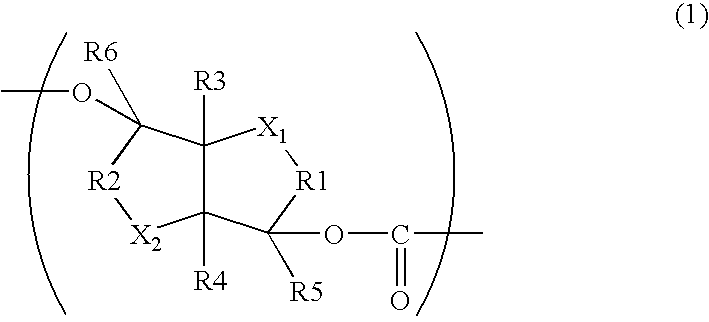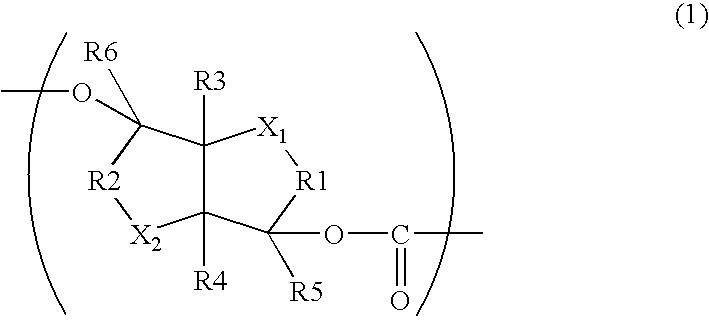Aliphatic polyester copolymer
a polyester and copolymer technology, applied in the field of high molecular weight aliphatic polyester copolymer, can solve the problems of reducing yield, difficult to say that the polylactic acid is adequate to use the same as a general-purpose resin, and large amount of expensive ipxtc, etc., and achieves adequate mechanical properties and melting properties, excellent heat resistance, and good stability
- Summary
- Abstract
- Description
- Claims
- Application Information
AI Technical Summary
Benefits of technology
Problems solved by technology
Method used
Image
Examples
production example 1
[0113]106.12 g of isosorbide (a reagent of Tokyo Chemical Industry Co., Ltd.), 80.15 g of acetonitrile and 126.40 g of pyridine were charged in a 500 ml round-bottom flask to dissolve isosorbide at room temperature. Because the inner temperature elevated after initiation of charging phosgene, 74.02 g of phosgene was charged over 2 hours while maintaining the inner temperature at 50° C. After aging at 50° C. for 1 hour, the reaction mass was transferred to a 1 liter beaker, where the reaction mass was diluted with 400 g of acetonitrile, and the reaction mass was clouded with 41.41 g of methanol. The clouded reaction mass was discharged in 3 liters of water having 150 ml of 1N-hydrochloric acid aqueous solution introduced therein to precipitate a polymer. After filtration, water washing was repeated several times, and methanol washing was conducted. After filtration, the polymer was dried at 50° C. under nitrogen atmosphere to obtain 111.88 g (=89.5%) of an aliphatic polycarbonate.
[01...
production example 2
[0115]106.19 g of isosorbide (a reagent of Tokyo Chemical Industry Co., Ltd.) and 376.28 g of pyridine were charged in a 1,000 ml round-bottom flask to dissolve isosorbide at room temperature. Because the inner temperature elevated after initiation of charging phosgene, phosgene was further charged while maintaining the inner temperature at 50° C. Because viscosity of the reaction mass increased during charging phosgene, 103.44 g of pyridine was added, and ultimately 89.0 g of phosgene was charged over 9 hours. After completion of charging phosgene, the reaction mass was transferred to a 2 liters beaker, and 750 g of chloroform and 100 g of methanol were charged to dilute the reaction mass. The reaction mass was discharged in 4 liters of methanol to reprecipitate the polymer, followed by filtration to thereby recover the polymer. The polymer recovered and 1,000 ml of 0.5N-hydrochloric acid aqueous solution were charged in a 2 liters beaker, and stirred at room temperature for 30 min...
example 1
[0117]18.06 g of a polylactic acid (H-100 grade) manufactured by Cargill Dow LLC, 12.00 g of the aliphatic polycarbonate synthesized in Production Example 1 and 91.22 g of 1,3-dimethyl-2-imidazolidinone were charged in a 300 ml round-bottom flask. After replacing the inner atmosphere with nitrogen, the temperature was elevated from room temperature to 140° C. under ordinary pressure / nitrogen atmosphere. At the time that the polylactic acid and the aliphatic polycarbonate synthesized in Production Example 1 were dissolved, 0.5552 g of tin octanoate, a reagent of Wako Pure Chemical Industries, Ltd., was charged to react at 140° C. / ordinary pressure under nitrogen atmosphere for 23 hours.
[0118]After completion of the reaction, the reaction mass was charged in 770 ml of 1N-hydrochloric acid aqueous solution to precipitate a polymer. After filtration, 700 ml of distilled water was charged to wash the polymer with the water. After filtration, the polymer was again washed with isopropyl al...
PUM
| Property | Measurement | Unit |
|---|---|---|
| haze | aaaaa | aaaaa |
| Tg | aaaaa | aaaaa |
| glass transition temperature | aaaaa | aaaaa |
Abstract
Description
Claims
Application Information
 Login to View More
Login to View More - R&D
- Intellectual Property
- Life Sciences
- Materials
- Tech Scout
- Unparalleled Data Quality
- Higher Quality Content
- 60% Fewer Hallucinations
Browse by: Latest US Patents, China's latest patents, Technical Efficacy Thesaurus, Application Domain, Technology Topic, Popular Technical Reports.
© 2025 PatSnap. All rights reserved.Legal|Privacy policy|Modern Slavery Act Transparency Statement|Sitemap|About US| Contact US: help@patsnap.com



